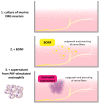Neurotrophins: Neuroimmune Interactions in Human Atopic Diseases
- PMID: 37047077
- PMCID: PMC10094011
- DOI: 10.3390/ijms24076105
Neurotrophins: Neuroimmune Interactions in Human Atopic Diseases
Abstract
Allergic diseases are accompanied by a variety of symptoms such as pruritus, coughing, sneezing, and watery eyes, which can result in severe physiological and even psychological impairments. The exact mechanisms of these conditions are not yet completely understood. However, recent studies demonstrated a high relevance of neurotrophins in allergic inflammation, as they induce cytokine release, mediate interaction between immune cells and neurons, and exhibit different expression levels in health and disease. In this review, we aim to give an overview of the current state of knowledge concerning the role of neurotrophins in atopic disorders such as atopic dermatitis, allergic asthma, and allergic rhinitis.
Keywords: allergic asthma; allergic rhinitis; atopic dermatitis; neurotrophin; pruritus.
Conflict of interest statement
The authors declare no conflict of interest.
Figures
Similar articles
-
Neuroinflammatory Gene Expression Pattern Is Similar between Allergic Rhinitis and Atopic Dermatitis but Distinct from Atopic Asthma.Biomed Res Int. 2020 Jun 10;2020:7196981. doi: 10.1155/2020/7196981. eCollection 2020. Biomed Res Int. 2020. PMID: 32596360 Free PMC article.
-
Differential up-regulation of neurotrophin receptors and functional activity of neurotrophins on peripheral blood eosinophils of patients with allergic rhinitis, atopic dermatitis and nonatopic subjects.Clin Exp Allergy. 2008 Sep;38(9):1493-8. doi: 10.1111/j.1365-2222.2008.03035.x. Epub 2008 Jul 17. Clin Exp Allergy. 2008. PMID: 18647313
-
Neurotrophins in healthy and diseased skin.G Ital Dermatol Venereol. 2010 Apr;145(2):205-11. G Ital Dermatol Venereol. 2010. PMID: 20467394 Review.
-
Impact of Gastroesophageal Reflux Disease on Mucosal Immunity and Atopic Disorders.Clin Rev Allergy Immunol. 2019 Oct;57(2):213-225. doi: 10.1007/s12016-018-8701-4. Clin Rev Allergy Immunol. 2019. PMID: 30206783 Review.
-
The role of neurotrophins in inflammation and allergy.Inflamm Allergy Drug Targets. 2010 Jul;9(3):173-80. doi: 10.2174/187152810792231913. Inflamm Allergy Drug Targets. 2010. PMID: 20553229 Review.
Cited by
-
TRPV1 Channel in Human Eosinophils: Functional Expression and Inflammatory Modulation.Int J Mol Sci. 2024 Feb 5;25(3):1922. doi: 10.3390/ijms25031922. Int J Mol Sci. 2024. PMID: 38339203 Free PMC article.
-
Causal association between circulating cytokine levels and the risk for asthma: A bidirectional, Mendelian randomization study.Medicine (Baltimore). 2025 Jul 18;104(29):e43364. doi: 10.1097/MD.0000000000043364. Medicine (Baltimore). 2025. PMID: 40696647 Free PMC article.
-
The airway neuro-immune axis as a therapeutic target in allergic airway diseases.Respir Res. 2024 Feb 8;25(1):83. doi: 10.1186/s12931-024-02702-8. Respir Res. 2024. PMID: 38331782 Free PMC article. Review.
-
Effect of Topical Corticosteroid Treatment on microRNA Expression in Infants with Atopic Dermatitis.JID Innov. 2025 Jun 10;5(5):100388. doi: 10.1016/j.xjidi.2025.100388. eCollection 2025 Sep. JID Innov. 2025. PMID: 40686936 Free PMC article.
-
Eosinophil extracellular vesicles and DNA traps in allergic inflammation.Front Allergy. 2024 Aug 1;5:1448007. doi: 10.3389/falgy.2024.1448007. eCollection 2024. Front Allergy. 2024. PMID: 39148911 Free PMC article. Review.
References
-
- Lambiase A., Bracci-Laudiero L., Bonini S., Bonini S., Starace G., D’Elios M.M., de Carli M., Aloe L. Human CD4+ T cell clones produce and release nerve growth factor and express high-affinity nerve growth factor receptors. J. Allergy Clin. Immunol. 1997;100:408–414. doi: 10.1016/S0091-6749(97)70256-2. - DOI - PubMed
-
- Kerschensteiner M., Gallmeier E., Behrens L., Leal V.V., Misgeld T., Klinkert W.E., Kolbeck R., Hoppe E., Oropeza-Wekerle R.L., Bartke I., et al. Activated human T cells, B cells, and monocytes produce brain-derived neurotrophic factor in vitro and in inflammatory brain lesions: A neuroprotective role of inflammation? J. Exp. Med. 1999;189:865–870. doi: 10.1084/jem.189.5.865. - DOI - PMC - PubMed
-
- Rodrigues-Amorim D., Iglesias-Martínez-Almeida M., Rivera-Baltanás T., Fernández-Palleiro P., Freiría-Martínez L., Rodríguez-Jamardo C., Comís-Tuche M., Del Vallejo-Curto M.C., Álvarez-Ariza M., López-García M., et al. The Role of the Second Extracellular Loop of Norepinephrine Transporter, Neurotrophin-3 and Tropomyosin Receptor Kinase C in T Cells: A Peripheral Biomarker in the Etiology of Schizophrenia. Int. J. Mol. Sci. 2021;22:8499. doi: 10.3390/ijms22168499. - DOI - PMC - PubMed
Publication types
MeSH terms
Substances
Grants and funding
LinkOut - more resources
Full Text Sources
Medical



